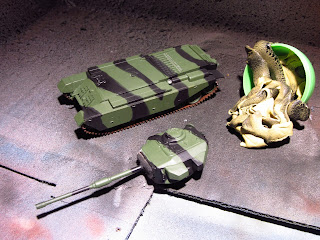This is the tiny Airfix OO scale (1:76.2 scale) 1964 kit (#A207V reboxed in 1971) of the British Army's CENTURION Mk.8. main battle tank showing how it would have looked while serving with the BAOR in late 1966 during an "Active Edge" combat exercise with the 6th Brigade near Soltau Germany against the 'enemy' Canadian Army using the same tank. The Centurion went into British service in 1945 and was replaced by the Chieftan in 1967. The Canadian Army used 347 Centurions until 1975. Some 4423 Centurions were built in 13 basic versions at four different factories: Leyland Motors, Lancashire; the Royal Ordnance Factory ROF Leeds; ROF Royal Arsenal, Woolich London; and Vickers in Elswick.
This was a 48 hours build of an ancient kit bought at a militaria sale for $5. The paint scheme was achieved using knock-off silly putty as masking. I added a cloth cover to the mantlet as shown on the boxtop. OOB including decals. I have not been able to identify the markings. The rubber tracks were too long, so I trimmed out about 10mm of track and stapled the ends together. The four staples are totally hidden by the skirts. The base is a repurposed marble drinks coaster. The plans in the box extol the virtues of this superb tank by mentioning how well it did in Suez in 1956. Very strange.
Bizarre Centurion fact: An Australian Army Mk 3 Centurion Type K, #169041, was involved in a nuclear weapons test in Australia in 1953 as part of Operation Totem 1. Emplaced only 500 m from ground zero, the tank withstood the 9.1 kt blast while being displaced 1.5 m, and having most large external parts ripped away and the glass ports and lights sandblasted. However, it still worked and was driven away from the test site. Later nicknamed the Atomic Tank, it was used by Australian armoured forces in the war in South Viet Nam, and in May 1969 was damaged by an RPG. Three crew were injured but the tank remained in combat condition. It is now a gate guard and museum piece at the Robertson Barracks in Palmerston, NT, Australia. 169041 is the only tank known to have been used as a target in a nuclear detonation and later used in combat.
 |
| Centurion Mk.8. British Army main battle tank, circa 1966 |
 |
| Centurion Mk.8. British Army main battle tank, circa 1966 |
 |
| Centurion Mk.8. British Army main battle tank, circa 1966 |
 |
| Centurion Mk.8. British Army main battle tank, circa 1966 |
 |
| Centurion Mk.8. British Army main battle tank, circa 1966 |
 |
| Centurion Mk.8. British Army main battle tank, circa 1966 |
 |
| Centurion Mk.8. British Army main battle tank, circa 1966 |
 |
| Centurion Mk.8. British Army main battle tank, circa 1966 |
 |
| Centurion Mk.8. British Army main battle tank, circa 1966 |
 |
| using silly putty knock-off for the paint scheme |
 |
| using silly putty knock-off for the paint scheme |








